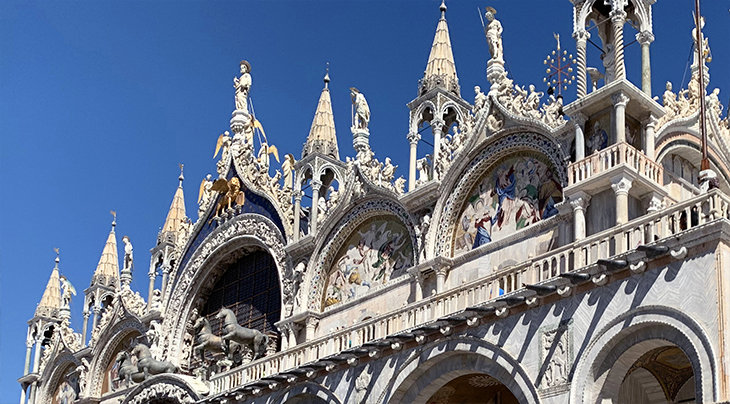The Heart of Venice: St. Mark's Square
Discover what you want to see when you can go to Italy and visit Venice’s Piazza San Marco. This huge piazza is dominated by St. Mark’s Basilica, one of the finest examples of Italian-Byzantine architecture in the world, built sometime in the latter half of in the 11th century. So inspiring is this area of Venice that many movies have been filmed here.
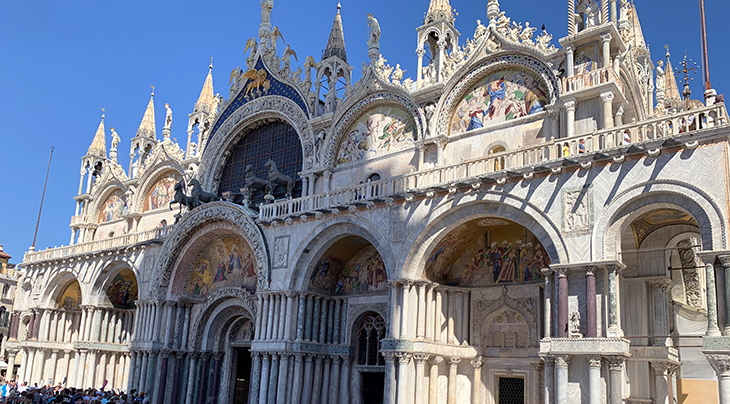 (St. Mark’s Basilica, Venice, Italy Photo © 2020 Anita Hamilton)
(St. Mark’s Basilica, Venice, Italy Photo © 2020 Anita Hamilton)
St. Mark’s Basilica
On a 2019 tour of Northern Italy with Insight Vacations, we spent a few days in Venice and wound up in St. Mark’s Square several times. During the day the Piazza San Marco is usually busy, with tourists from all over the world to this top travel destination for cruises and air travelers. Lineups to get into the Basilica of Saint Mark and other historical buildings are long-ish.
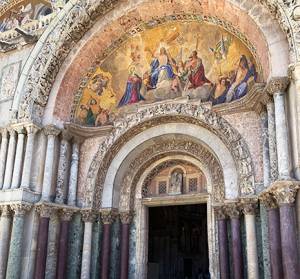 (St. Mark’s Basilica Entrance Mosaic Photo © 2020 Anita Hamilton)
(St. Mark’s Basilica Entrance Mosaic Photo © 2020 Anita Hamilton)
The history behind the beginning of St. Mark’s church in Venice goes back to 828 AD.
St. Mark (aka Mark the Evangelist) is said to be one of the disciples of Jesus of who inspired and/or wrote the Gospel of Mark.
He traveled to Egypt and founded the Church of of Alexandria there around 42 AD.
In 828 AD, a couple of enterprising Venetian merchants stole his remains from the church in Alexandria, which was at risk of being plundered or torn down to be replaced with a mosque. According to the Basilica of San Marco, the Venetian merchants hid St. Mark’s relics in wicker baskets and declared them as pork, so the Muslim customs officers would not look in the containers.
When the Doge (Duke) of Venice (Giustiniano Particiaco) received the remains, he ordered a church to be built adjacent to the Doge’s Palace, as a private chapel and to house St. Mark’s relics.
St. Mark was declared the patron saint of Venice. The symbol of St. Mark and thus of Venice is the winged lion – this symbolism is prominent throughout the city today, and especially in Piazza San Marco and the Basilica.
During a rebellion in 976 the first St. Mark’s Church was burnt down, thus prompting the building of the newer and much larger basilica (built of brick), and a new Doge’s Palace.
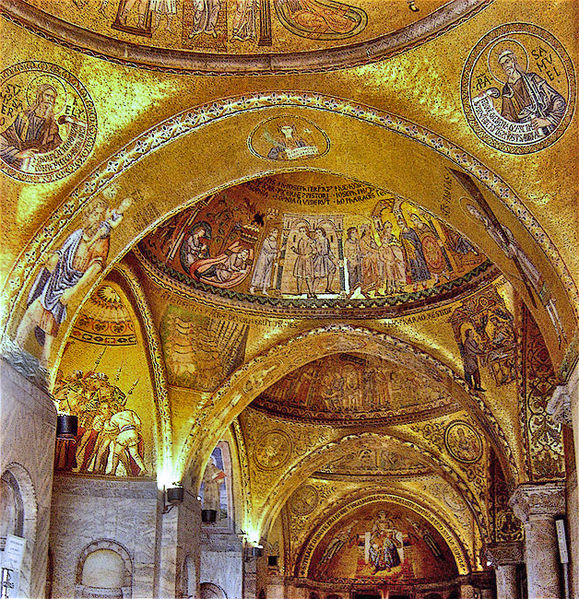 (St. Mark’s Basilica Interior Gold Mosaics 2005 Photo: Ricardo André Frantz / I, Tetraktys)
(St. Mark’s Basilica Interior Gold Mosaics 2005 Photo: Ricardo André Frantz / I, Tetraktys)
St. Mark’s Church is also known as Chiesa d’Oro (Church of Gold) because of the gold ground glass mosaics covering the upper inside of the church.
The ornate decorations (mosaics, sculptures, marble cladding and flooring) covering the underlying brick on the exterior, and on the inside of the basilica, took hundreds of years to complete.
During the Fourth Crusade (1202-1204 AD) French and Italian knights sacked Constantinople, and several treasures from there ended up in Venice.
Among these treasures are the Portrait of the Four Tetrarchs, a sculpture of four Roman Emperors c. 300 AD, set at ground level into the south-west corner of the Basilica.
Also from Constantinople are four large “bronze” (actually 97% copper) sculptures known as the Roman Horses of Saint Mark-Lysippos (aka The Triumphal Quadriga), estimated to date back to around 100-200 AD. The four horses were placed on a narrow balcony above the portal of the church, below the gold Lion of St. Mark with the statue of Saint Mark above that, in 1254 AD.
(St. Mark’s Basilica – Four Horses, Status and Lion of St Mark Photo © 2020 Anita Hamilton)
When French General Napoleon Bonaparte invaded Northern Italy and conquered The Republic of Venice in 1797, he had the four Roman horses removed and taken to Paris; they were returned to Venice in 1815 after Napoleon was defeated.
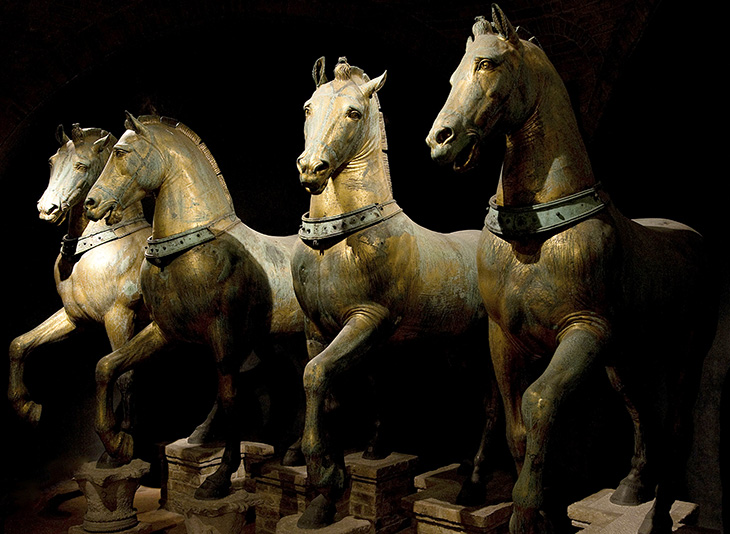 (Four Horses of St Mark-Lysippos / Triumphal Quadriga 2008 Photo: Tteske)
(Four Horses of St Mark-Lysippos / Triumphal Quadriga 2008 Photo: Tteske)
In order to preserve these valuable sculptures, during the 1980s the four horses of St. Marks were removed and put inside the Basilica; exact copies were put in their place on the outside.
 (Procession of the True Cross in Piazza San Marco 1496, Gentile Bellini | Photo 2016 Didier Descouens)
(Procession of the True Cross in Piazza San Marco 1496, Gentile Bellini | Photo 2016 Didier Descouens)
Above, as St. Mark’s Basilica appeared in 1496 to painter Gentile Bellini.
Doge’s Palace, St. Mark’s Square
Unlike the English royal dukes, whose titles were created by the ruling monarchy, and who passed down their title to descendants even today, the position of Doge of Venice was an elected leadership position in the Republic of Venice (726 – 1797 AD).
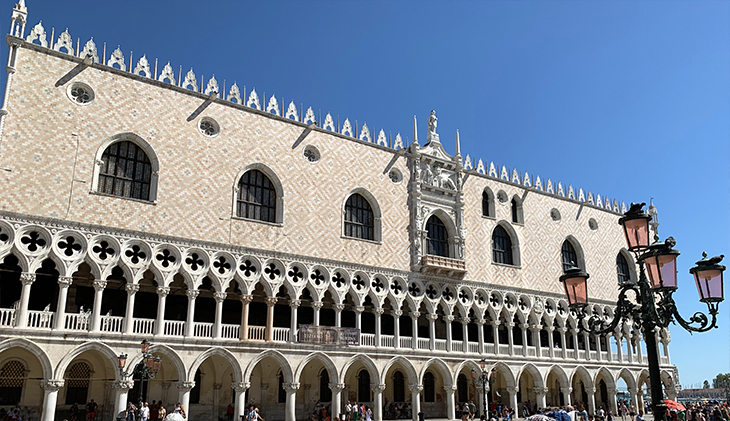 (Doge’s Palace, St. Mark’s Square, Venice, Italy Photo © 2020 Anita Hamilton)
(Doge’s Palace, St. Mark’s Square, Venice, Italy Photo © 2020 Anita Hamilton)
Construction began on the Venetian Gothic Doge’s Palace in 1340 AD. It replaced a previous, much smaller palace built on the same site around 1172-1178. The need for expansion, and three of large fires in the the palace fueled subsequent renovations, additions and enhancements to the palace in subsequent centuries.
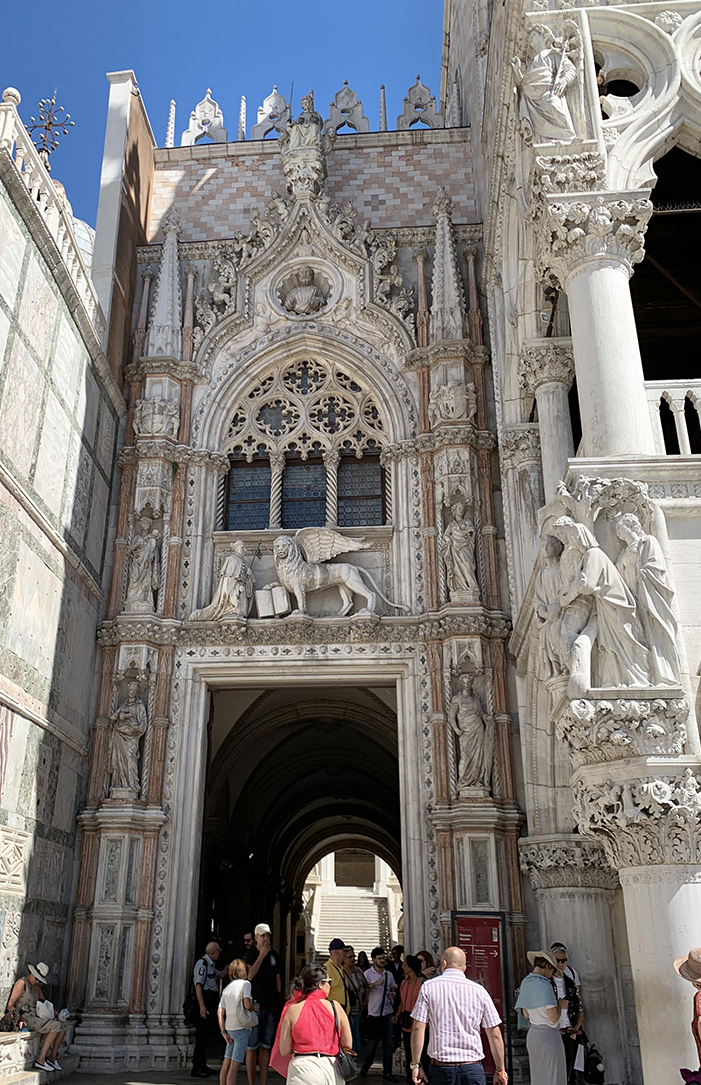 (Doge’s Palace Entrance, St. Mark’s Square, Venice, Italy Photo © 2020 Anita Hamilton)
(Doge’s Palace Entrance, St. Mark’s Square, Venice, Italy Photo © 2020 Anita Hamilton)
The Doge’s Palace Porta della Carta – a ceremonial entrance to the palace built and decorated between 1438-1442 – is at the north-western corner of the palace and is attached to the Basilica of St. Mark.
Just above the entrance you can see a statue of Doge Francesco Foscari (Doge from 1423-1457 AD) kneeling before the Lion of St. Mark.
This sculpture is from the 1800s, made to replace the original destroyed in 1797 when the Republic of Venice fell to Napoleon’s troops.
At the top of the window above the Doge and lion, is a bust of Mark the Evangelist; at the very top of this ornate sculpture is a statue of Justice (with scales and a sword).
In addition to private apartments for family members of the reigning Doge of Venice (until 1797, when the Republic of Venice ended with Bonaparte’s invasion), the palace had many public rooms inside, and was effectively the seat of government, and justice system for the Venetian Republic.
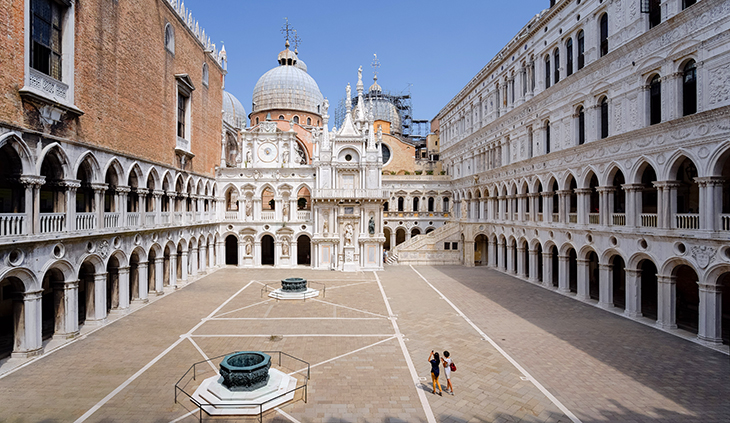 (Courtyard of the Doge’s Palace 2015 Photo: Benh LIEU SONG)
(Courtyard of the Doge’s Palace 2015 Photo: Benh LIEU SONG)
Two well-heads from the 1500’s are in the middle of the inner courtyard of the Doge’s Palace. The domes of St. Mark’s Basilica are visible at the north end above the sculptures and staircase.
The Doge’s Palace is connected to St. Mark’s Basilica on the north end, while the west facade faces out onto the Piazza San Marco, the south faces the Venetian Basin / Lagoon, and the east is on the Rio del Palazzo canal, facing the Doge’s Palace Prison.
Initially there were prison cells inside the Doge’s Palace, but by the mid-1600s a new Doge’s Palace Prison building had been built on the other side of the Rio del Palazzo Canal.
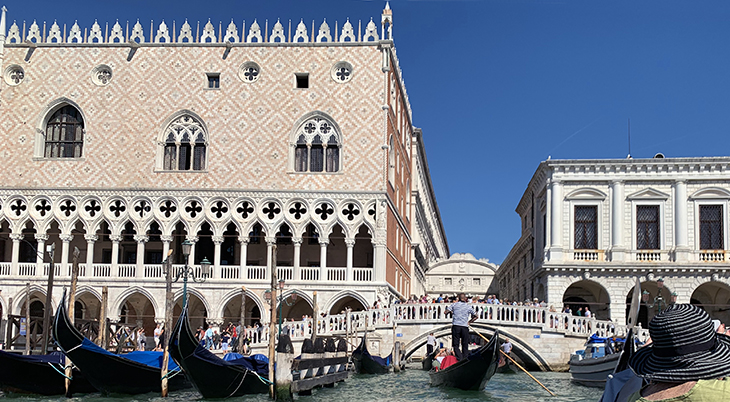 (Venice Doge’s Palace, Ponte della Paglia & Bridge of Sighs, and Prison Photo © 2020 Anita Hamilton)
(Venice Doge’s Palace, Ponte della Paglia & Bridge of Sighs, and Prison Photo © 2020 Anita Hamilton)
The famous covered Bridge of Sighs connects the Doge’s Palace inquisition rooms to the prison on the other side of the Rio Del Palazzo canal.
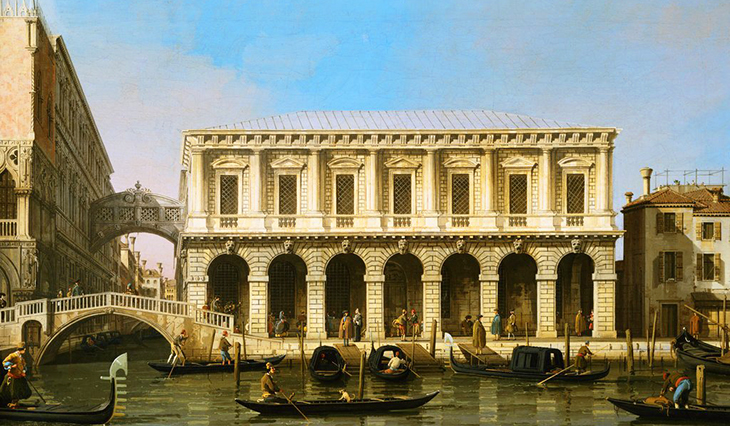 (Bridge of Sighs & Doge’s Palace Prison c. 1740s Painting Canaletto)
(Bridge of Sighs & Doge’s Palace Prison c. 1740s Painting Canaletto)
During the late 1800s, public offices in the Doge’s Palace were moved to other buildings in Venice to allow for restoration works. The Doge’s Palace has been a museum since 1923.
Othello (1995) starring Laurence Fishburne as “the Moor of Venice, Othello“, with Kenneth Branagh, Irene Jacob, Nathaniel Parker, and Michael Sheen. This version of Othello filmed in Venice and at Rome’s Orsini Castle. The 1951 film version of Othello stars Orson Welles, and was filmed at several locations in Morocco as well as the Doge’s Palace in St. Mark’s Square. Funnily enough, although the Palazzo Contarini Fasan (aka Casa di Desdemona) is said to be home to the real-life “Moor” and his wife Desdemona, who inspired Shakespeare to write the play, it’s not been a film location in Venice – yet. You can read more about this in Venetian Palazzos in Movies and Plays. Sadly, some other versions of Othello never even filmed a scene in Venice:
-
- O (2001), set in modern times and filmed in South Carolina, has Mekhi Phifer, Julia Stiles, Josh Hartnett, Andrew Keegan, John Heard, and Martin Sheen in the cast.
- Othello (1965) starring Laurence Olivier, was filmed at a studio in England.
St. Mark’s Square Landmarks
St. Mark’s Clocktower
Buildings were torn down so that construction could begin on a clocktower for St. Mark’s Square in 1496. The tower was unveiled in 1499 and the attached building wings on either side of the clocktower were completed by 1506.
Below you can see that at ground level, a two-storey tall archway allows access to the Merceria street, which leads north to the Rialto shopping area and bridge on the Grand Canal. The centre of the next two storeys is a large clock face with a golden pointer on a blue background. The inner circle of dark blue has stars on it; the middle circle has astrology symbols atop a mid blue-gray background, and the outer circle is of marble with Roman numerals etched into it.
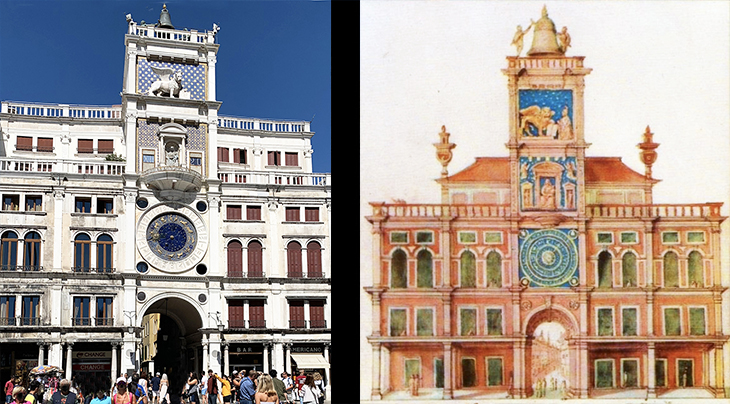 (St. Mark’s Clocktower © 2020 Anita Hamilton | 1538-1540 Drawing Francisco de Holanda)
(St. Mark’s Clocktower © 2020 Anita Hamilton | 1538-1540 Drawing Francisco de Holanda)
A stone Lion of St. Mark with his paw atop a book is at the terrace level of the tower. The statue of Doge Agostino Barbarigo kneeling before the lion, which can be seen in the 1538-1540 drawing by Francisco de Holanda above, is missing from the 2020 photo. When Bonaparte conquered Venice in 1797 the statue was removed as part of a city-wide purge by the French, of symbols of the previous government.
Above the Lion of St. Mark is a large bronze bell (c. 1497 AD) with two hinged statues of shepherds on either side of it. The bronze has darkened with age and the two shepherds are known as “the Moors” because of this. Both figures bend at the waist to strike the bell on the hour.
Above the level of the clock is a statue of the Virgin and Child, with doors on either side of it. The door on the left has the hour in Roman numerals, and on the right door are the minutes in Arabic numerals.
(St. Mark’s Clocktower Virgin and Child Photo © 2020 Anita Hamilton | 3 Magi Photo: Aw58)
Twice a year – Epiphany (January 6th) and Ascension Day (40 days after Easter), the two doors open and an angel followed by 3 Magi emerges to circle around the gallery and bow to the Virgin and Child, exiting by the other door.
St. Marks Piazzetta
The open space between the Doge’s Palace and the Marciana Library is called St. Mark’s Piazzetta. At the entrance of it are two tall columns, with the Lion of St. Mark atop one column, and Saint Teodoro on the other. From the Piazzetta, the Church of San Giorgio Maggiore on San Giorgio Maggiore Island in St. Mark’s Basin of the Venetian Lagoon, is easily visible.
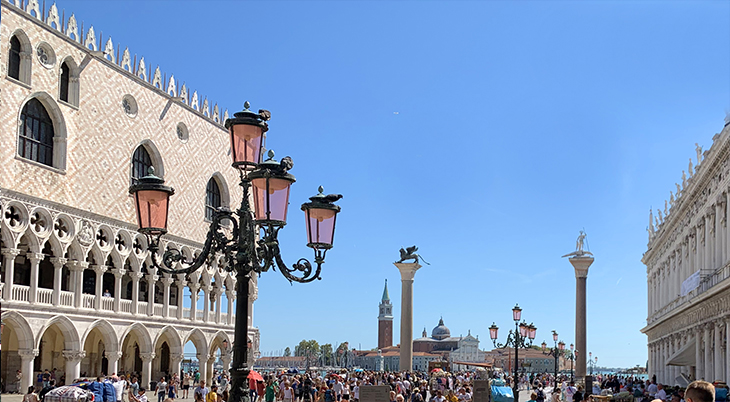 (San Giorgio Maggiore Church and Island From St. Mark’s Square Photo © 2020 Anita Hamilton)
(San Giorgio Maggiore Church and Island From St. Mark’s Square Photo © 2020 Anita Hamilton)
Marciana Library
The Marciana Library (on the right in the above photo, and close-up below), is a beautiful example of Venetian High Renaissance architecture, built between 1537-1588 AD. Statues of ancient heroes line the top of the library roofline.
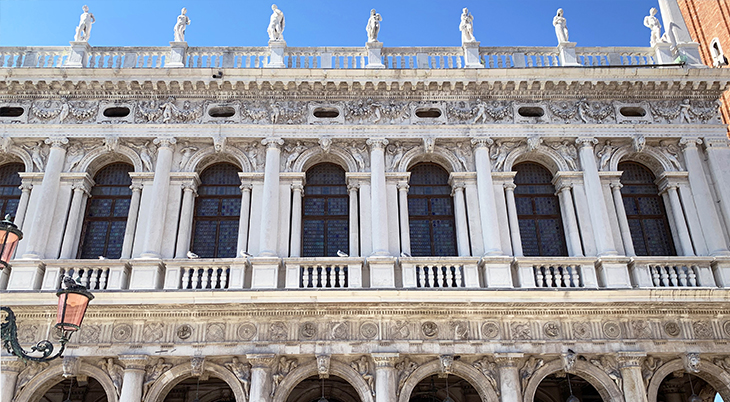 (Marciana Library, St. Mark’s Square, Venice, Italy Photo © 2020 Anita Hamilton) 2639
(Marciana Library, St. Mark’s Square, Venice, Italy Photo © 2020 Anita Hamilton) 2639
There are almost no plain wall visible on the exterior of the Marciana library, as carvings cover most it. Doric columns on the floor have arches between them; busts of Roman and Greek gods (ie Apollo, Venus, etc.) and lion’s heads alternate at the top of each arch.
Procuratie and St. Mark’s Bell Tower
Rising high above all of the other magnificent buildings in and around St. Mark’s Square is the 323′ tall brick St. Mark’s Campanile or Bell Tower. Building began on the first bell tower in the 9th century AD, and this initial tower was only completed in the mid-1100s. Lightning strikes, fire, and a devastating earthquake in the 1500s, required many restorations and repairs to the bell tower in succeeding centuries.
A brick bell tower was built in 1513 and lasted four hundred years, until the bell tower collapsed in 1902. A new, reinforced bell tower and elevator were built in 1912, otherwise replicating the previous structure.
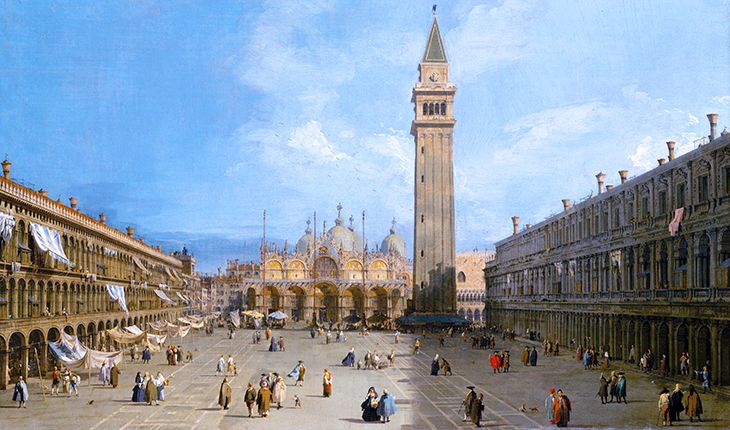 (St. Mark’s Square / Piazza San Marco, Venice, c. 1720s by Canaletto)
(St. Mark’s Square / Piazza San Marco, Venice, c. 1720s by Canaletto)
Above, a historical painting of St. Mark’s Square and the buildings around it – the Procuratie Vecchie on the left, the Procuratie Nuove on the right, the Bell Tower, and St. Mark’s Basilica – by Canaletto, who painted this scene several times.
The long Procuratie Vecchie and Nuove buildings on either side of St. Mark’s Square were built in the 1500s for the procurators of Saint Mark, high-ranking officials in the Republic of Venice Government. The ground floor of both buildings housed shops and restaurants, while above were private apartment for the procurator’s to live and rent out.
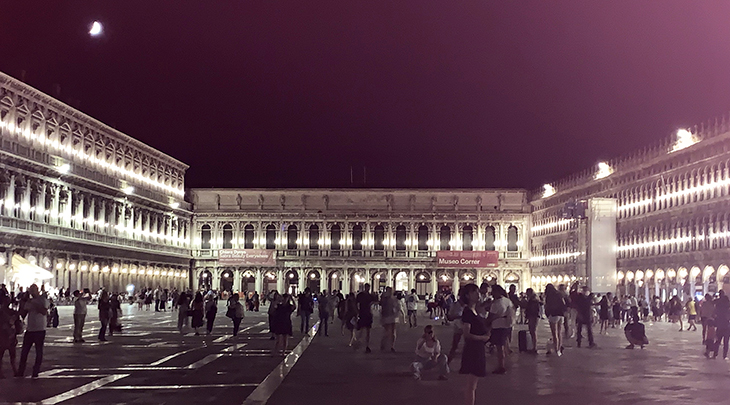 (St. Mark’s Square Procuratie Buildings, Venice Photo © 2020 Anita Hamilton)
(St. Mark’s Square Procuratie Buildings, Venice Photo © 2020 Anita Hamilton)
When the Republic of Venice fell to Napoleon (1805-1815), a third end wing that connects the two older Procuratie buildings and faces the Basilica and Bell Tower, was built – the Procuratie Nuovissime or Napoleonic Wing. Today all these historic Procuratie buildings house museums, offices, stores, and cafes.
We ascended the bell tower by elevator. A plaque dedicated to Italian astronomer Galileo Galilei commemorates the demonstration of his telescope to the Doge of Venice in 1609 from this spot, for having “widened the horizons of man”. You can walk around the top and discovered spectacular 360 degree views of Venice, St. Mark’s Square, St. Mark’s Basin in the Venetian Lagoon, and surrounding areas.
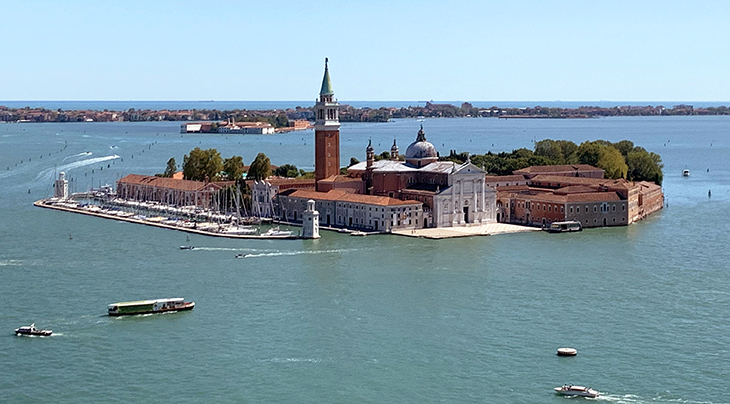 (San Giorgio Maggiore Island & Church from St. Mark’s Bell Tower Photo © 2020 Anita Hamilton)
(San Giorgio Maggiore Island & Church from St. Mark’s Bell Tower Photo © 2020 Anita Hamilton)
If you get tired of wandering around looking and the amazing buildings in the area of St. Mark’s, there’s plenty of shopping from vendors in the plaza itself as well as on the nearby sidestreets.
In the evening when many tourists and daytrippers have left old Venice, St. Mark’s Square is much quieter. The ancient buildings are lit up and it’s less hot, so it’s a good time of day to take your time to walk around the heart of Venice, St. Mark’s Square.
St. Mark’s Square Film Locations
Casanova (2005), a period historical drama directed by Lasse Hallstrom based on the life of the womanizing Italian author and adventurer Giacomo Casanova (Heath Ledger). Among the large supporting cast of Casanova are Sienna Miller as Casanova’s love Francesca, Jeremy Irons, Oliver Platt, Lena Olin, and Charlie Cox. St. Mark’s Square in Venice was the setting for a dramatic hanging (and escape) scene in Casanova. A couple of earlier movies featuring the character of Casanova were also filmed in Italy:
- Some Like it Cool (1979) starring Tony Curtis as Giacomo Casanova, in a funny sex romp with actresses Marisa Berensen, Sylvia Koscina, and others, filmed in Venice.
- Fellini’s Casanova (1976) is an earlier and perhaps the most well-known film based on Casanova. It’s a weird film even according to star Donald Sutherland, and although it’s set in Venice it was filmed primarily at movie studios in Rome, Italy.
The 15:17 to Paris (2018), director Clint Eastwood‘s recounting of the three Americans traveling in Europe, who thwarted a terrorist attack on a train headed to Paris. The 15:17 to Paris filmed in several countries including Atlanta (U.S.), Paris (France), Brussels (Belgium), Amsterdam (Netherlands), and Venice, Rome & Vatican City (Italy). St. Mark’s Square and the Basilica appear in scenes from the film.
Youth (2015), a comedy-drama starring Michael Caine and Harvey Keitel as friends vacationing in the Alps; Rachel Weisz has a supporting role. Switzerland, England, and Italy provided film locales for Youth, with a key dream sequence taking place at St. Mark’s Square in Venice
Blume in Love (1973), a romantic comedy with George Segal, Susan Anspach, Kris Kristofferson, Marsha Mason, Shelley Winters, and Paul Mazursky, features St. Mark’s Square in Venice.
Death in Venice (1971), a drama with Dirk Bogarde and Marisa Berensen. Filmed in Rome, the Dolomites, Bolzano, Trentino, and Venice, of course! St. Mark’s Square and Teatro La Fenice are featured locales for Death in Venice.
Just Married (2003), a rom-com starring Ashton Kutcher and Brittany Murphy, with David Rasche and Thad Luckinbill. Bolzano and St. Mark’s Square in Venice are among several Italian film locations for Just Married.
Inferno (2016), a dark thriller starring Tom Hanks, filmed in Turkey, Hungary, and Italy. If you watch Inferno closely you may recognize scenes filmed in Florence‘s Boboli Gardens & Ponte Vecchio, and Piazza San Marco in Venice.
The Italian Job (2003), an action-adventure movie with Donald Sutherland, Edward Norton, Mark Wahlberg, Charlize Theron, Seth Green, and Jason Statham. Filming for The Italian Job took place in Venice’s Campo San Barnaba, Genoa, Trento, as well as several California locations.
Casino Royale (2006), with Daniel Craig as James Bond, and Eva Green, Mads Mikkelsen, Judi Jench, Jeffrey Wright, and Giancarlo Giannini in supporting roles. Italian film locations for Casino Royale included Lake Como, the Bahamas, Prague and the Czech Republic, the U.K., and Venice – the Grand Canal, several shots in St. Mark’s Square, Campo San Barnaba, and Giudecca Island in the Venetian Lagoon.
*This article is for general informational purposes only. 50+ World does endorse these providers, nor does it receive remuneration from them.*
**Unless indicated otherwise, all photographs & text in this article are © 2019 Anita Hamilton. All rights reserved. Do not download or reproduce without written permission. Other images are either presumed to be in the public domain and/or creative commons licensed and sourced via Wikimedia Commons or Flickr**

